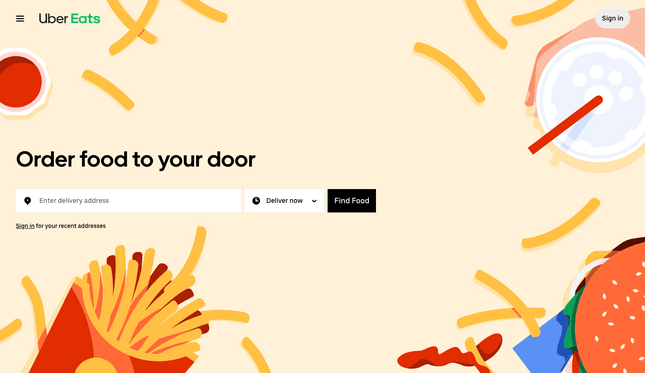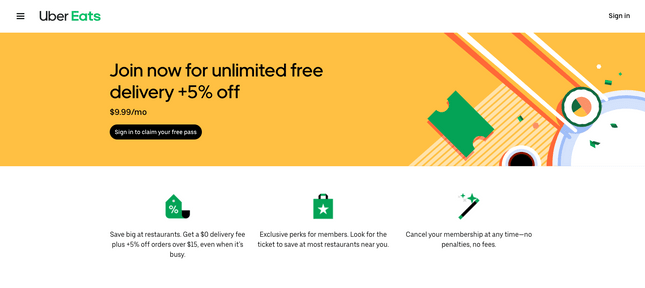Food Delivery Trends: How Will it Impact Your Online Food Business?
If you click to purchase a product or service based on our independent recommendations and impartial reviews, we may receive a commission. Learn more
As technology develops and new, faster tools become widely available, the value of convenience has become increasingly important over time. There are few spaces where this is clearer to see than with food delivery.
In recent years we have seen a huge growth in businesses selling food online, providing everything from groceries to recipe boxes and fast food. In fact, McKinsey & Company estimates that the food delivery market was worth a massive $150 billion in 2021, more than triple its value in 2017.
Being such a potentially lucrative market, it is hardly surprising that businesses are always looking for new, better ways of doing things. So, if you want to be in the know on all the latest food delivery industry trends, or you simply want a little inspiration for your next business move – check out our 11 delivery food trends.
More Third-Party Delivery

Third-party delivery companies have totally revolutionized the food delivery space. Not that long ago, food delivery was limited to either massive companies that have the resources and structures to offer delivery (often pizza) or small businesses that could personally offer super-localized delivery.
Companies such as Uber Eats, DoorDash, and GrubHub have blown the delivery space wide open, making it significantly easier for businesses of all sizes to sell food online and have it delivered straight to customers.
With industry leaders such as Uber Eats, which controls over 25% of the food delivery market in the US, making a massive $4.8 billion in 2020, it is likely that we will see more third-party delivery companies entering the mix.
Increased competition could help drive down delivery commissions, which are often large, helping food businesses to increase profits and generate more custom.
Proliferation of Food Delivery Apps
There are lots of elements that come into play when creating a successful food business such as flavor, choice, cost, and nutritious value. However, arguably the biggest factor when it comes to food delivery is convenience.
This is why industry leaders invest so heavily in creating and rolling out apps that help customers easily order food at their convenience, right from their mobile devices. These apps are often rolled out by third-party delivery companies such as DoorDash and GrubHub but are also created by food businesses such as McDonald’s.
As apps and their supporting systems become more widely available and affordable, we are likely to see more food businesses of all sizes rolling out their own apps. This will help these businesses to minimize delivery commissions, as well as benefiting from the collection of customer data.
We are also likely to see businesses plug the functionality of delivery apps into their own websites in order to offer greater convenience to their customers.
Roll Out of Delivery Management Software
Delivery Management Software is used by many businesses to help keep track of deliveries every step of the way. These are widely used by delivery businesses such as FedEx and UPS to streamline the delivery process from beginning to end.
Food businesses and third-party delivery companies are also now starting to adopt advanced Delivery Management Software to help them manage their own deliveries quickly and easily.
As an online food business owner, adopting industry-specific Delivery Management Software can help you to analyze delivery data and optimize processes to reduce waiting times and minimize costs. In fact, some restaurant website builders now include management software exactly for this purpose.
Tech Giants Enter the Market

Massive online food delivery growth hasn’t gone unnoticed, with tech giants such as Amazon and Google starting to roll out their own delivery services across the globe.
This presents food business owners with an opportunity to partner with these tech giants at an early stage and benefit from the likely growth that these well-funded services will see in the coming years.
Rapid Growth of Grocery Delivery
Online grocery sales in the USA have grown at an increasing rate over the past few years and are predicted to reach $120 billion by 2026. This has likely been fuelled by the pandemic, which ignited growth through increased awareness of grocery delivery services.
As awareness continues to grow and industry developments make grocery delivery easier and cheaper, online food businesses that offer delivery or partner with a grocery delivery provider will be able to tap into an ever-growing customer base.
Growth in Food Delivery Subscriptions

With convenience at the heart of online delivery, subscriptions are the next step in making food delivery even less taxing for consumers. Subscriptions can be found in all areas of food delivery, from subscriptions to third-party fast food delivery services like Uber Eats ‘Eats Pass’ to subscriptions to popular recipe boxes.
Automated subscriptions to food delivery boxes help consumers to ensure their needs are always met without the hassle of repetitive ordering. In turn, this offers food businesses an opportunity to increase the amount and consistency of profit they are able to make from each of their customers.
Food Delivery and Virtual Cooking Classes
Recipe boxes are an online food ordering trend that has exploded in popularity in recent years. Offering consumers a convenient way to cook delicious, often healthy meals without hassle and waste. The next step in the progression of this food delivery service is the introduction of virtual cooking classes to complement the recipes sent with the box.
This approach opens up opportunities for delivery companies to move from a space of pure convenience into a space of learning and experience. The types of cooking lessons could span from simple recipes and the basics through to cooking with celebrity chefs or learning advanced cooking techniques.
The majority of food businesses could jump on this trend of turning convenience into an experience by expanding or starting a food blog, offering how-tos and virtual lessons associated with their own goods and services.
Automated Delivery

Companies such as Amazon are already rolling out new automated delivery systems such as the use of drones with Amazon Air. This type of delivery is likely to make its way into the food industry, with some companies such as JustEat already trialing drones for fast food delivery.
Delivery from the location of production to the end customer is one of the most time-consuming and costly aspects of the food supply chain. The introduction of drones and driverless vehicles will help food businesses to reduce costs and better serve their customers.
Eco-Friendly Food Delivery

Sustainability and eco-friendliness are big news, which in turn makes them big selling points for businesses that can offer greener food delivery options. This approach can take many forms, such as food being delivered by low or zero-emission vehicles like electric cars or bicycles. It may also include delivering food that is ethically sourced and has a low carbon footprint.
In fact, one survey by GreenPrint found that 78% of Americans surveyed were more likely to buy a product that is clearly labeled as environmentally friendly.
Food business owners that can offer a more sustainable option and clearly market their eco-friendly credentials will be able to tap into this growing trend.
Cloud Kitchens
Cloud Kitchens, also often referred to as Ghost Kitchens, are a relatively new phenomenon that is building off the success of fast food delivery services.
Typically a delivery service would take an order for an established restaurant and then collect and deliver that order from the restaurant’s premises. A cloud kitchen takes orders in a similar way. However, instead of collecting the order from an established restaurant, they collect the order from a dedicated unit where several delivery-exclusive food production businesses are based.
These food production businesses don’t operate as established restaurants as they have no premises that can be visited by customers. Instead, they operate purely as a kitchen, producing food for delivery services such as Uber Eats.
Hyperlocal Food Delivery
Hyperlocal food delivery jumped into the spotlight throughout the pandemic to tackle one of the biggest issues food businesses faced with third-party delivery businesses such as UberEats – commissions.
Due to restrictions imposed on food businesses during the pandemic, many of them turned to third-party delivery businesses to help them continue serving their customers in the local area. However, with many small businesses only making small profit margins on each sale and the restrictions imposed throughout the pandemic further damaging their income, the large commissions charged by these apps are often untenable.
This is where hyperlocal food delivery came in. These are smaller, local organizations that offer similar services to big third-party delivery businesses. However, they usually charge a fraction of the commission and exclusively serve a small geographical location.
The benefit of food businesses working with hyperlocal local food delivery organizations is clear – smaller commissions, resulting in bigger profits.
Food Delivery Trends: Summary
It’s clear that there are big opportunities afoot for food businesses. Although many different approaches are being taken, there are obvious themes throughout the trends in food delivery we have highlighted above. These include increasing customer convenience and reducing costs.

Leave a comment